DrScrabs
Hazard to Others
  
Posts: 123
Registered: 13-3-2018
Location: Laputa
Member Is Offline
Mood: Still evaporating..
|
|
1952 soviet dentist amalgam composition
So I went to a flea market and got some amalgam, I think it is yet to be mixed with Hg, and was wondering about the composition.
Wiki says that in the first half of the 20th century they used mostly premixed copper amalgam, wich had to be heated to use it. Nowdays it has a
composition of about 40% Silver, max 32% Tin, max 30% Copper, max 5% Indium, maxi 3% Mercury and max 2% Zinc.
I hope it to be Silver amalgam of course 
Sadly I dont speak or read russian and nobody was able to help me yet with the instructions that were included. Maybe here is somebody who is able to
help. But the photos of the instruction are horrible so I will post scans when I am home on thursday.
Thank you!
DrScrabs
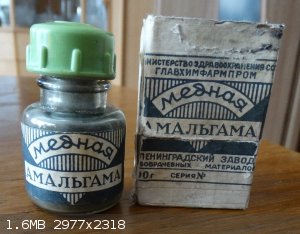
|
|
|
DrScrabs
Hazard to Others
  
Posts: 123
Registered: 13-3-2018
Location: Laputa
Member Is Offline
Mood: Still evaporating..
|
|
Managed to get the photos right 
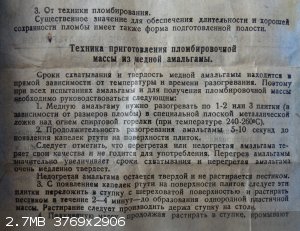
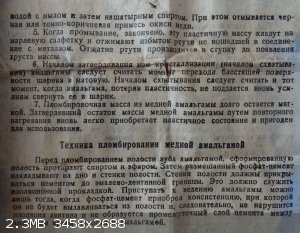
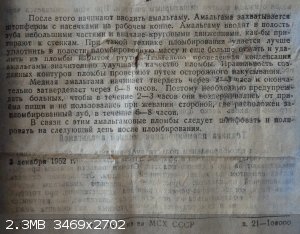
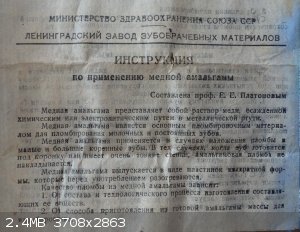
|
|
|
Ubya
International Hazard
    
Posts: 1232
Registered: 23-11-2017
Location: Rome-Italy
Member Is Offline
Mood: I'm a maddo scientisto!!!
|
|
you could try the app version of google translate, it has a camera function that can translate live writings on things (thats how i found out in the
Netherlands that the milk carton i bought was porridge, ans not chunky expired milk)
---------------------------------------------------------------------
feel free to correct my grammar, or any mistakes i make
---------------------------------------------------------------------
|
|
|
TheMrbunGee
Hazard to Others
  
Posts: 364
Registered: 13-7-2016
Location: EU
Member Is Offline
Mood: Phosphorising
|
|
the text is all instructions on use for filling cavities, but it is called "copper amalgam" ,so I suspect there is copper.
My rusty russian would use more time than I got right now, but running trough it I did not see any indigents listed. But I am sure that it is premixed
copper amalgam you mentioned.
edit:
Silver ones comes in 2 parts, silver + other metals powder and Hg. You mix them right before filling cavity.
[Edited on 12-8-2019 by TheMrbunGee]
|
|
|
teodor
National Hazard
   
Posts: 872
Registered: 28-6-2019
Location: Heerenveen
Member Is Offline
|
|
This instruction clearly says that this is a"copper precipitated from a solution by chemical or electrical way already mixed with mercury. The first
part describes the preparation of a dental filling with removing excess of mercury which should appear on the surface of bricks after heating as
drops.
Well, you can U2U me if need some translation from Russian 
[Edited on 13-8-2019 by teodor]
[Edited on 13-8-2019 by teodor]
|
|
|
DrScrabs
Hazard to Others
  
Posts: 123
Registered: 13-3-2018
Location: Laputa
Member Is Offline
Mood: Still evaporating..
|
|
Thanks teodor.
Good to know its the copper amalgam, now I just have to find a way to get the mercury 
I think I will dissolve all in nitric acid and displace the Hg(II) with some copper.
Or does somebody have a better idea?
|
|
|
egret
Harmless

Posts: 20
Registered: 22-2-2018
Member Is Offline
Mood: No Mood
|
|
I am afraid you get the copper amalgam back. Or the mercury will be contaminated by copper. The comosition of this amalgam is 32—37% Cu, 59—66%
Hg, 2—4% Zn
|
|
|
DrScrabs
Hazard to Others
  
Posts: 123
Registered: 13-3-2018
Location: Laputa
Member Is Offline
Mood: Still evaporating..
|
|
I don´t think I will get the amalgam again. I will use 1-2mm copper wire and immerse it into the liquid without going to the bottom of the beaker.
That way the mercury wick forms on the surface will drip off. It will be contaminated wirth copper of course but the contamination is much less Cu
than the starting amalgam, so to clean the mercury, I will have to stir it in KMnO4 soln to oxidise the Cu, then wash with dilute acid to get rid of
the oxides.
But hey, i payed like 15 Eur for it, if I get 60g of Hg, that was worth it for me.
[Edited on 15-8-2019 by DrScrabs]
|
|
|
DrScrabs
Hazard to Others
  
Posts: 123
Registered: 13-3-2018
Location: Laputa
Member Is Offline
Mood: Still evaporating..
|
|
I got an good idea how to seperate the copper and mercury without distillation. As I need the Hg as Hg(II) this may be the best way for me.
First dissolve the amalgam in excess azeotropic HNO3.Then dilute with some water and boil the soln for a few minutes to get rid of dissolved NOx.
There will be a soln of Cu(NO3)2 and Hg(NO3)2. Then the minimum amount of aq ammonia is added to precipitate Cu(OH)2. Hg(NO3)2 is not affected by aq
ammonia if I remember right. The presence of Cu(II) can be easily determined by the colour of the solution.
Filter and then boil dry and decompose the Hg(NO3)2 to HgO. Then proceed with the acid of your choice to get Hg(II).
What do you think about?
|
|
|
teodor
National Hazard
   
Posts: 872
Registered: 28-6-2019
Location: Heerenveen
Member Is Offline
|
|
Well, I think that upon addition HNO3 will react with Cu first and then with Hg (based on reactions between Cu metal and Hg salts - it always deposits
Hg).
The main problem with any method of separation I think is volatility of Hg salts. I have no experience with that so probably would do heating/boiling
of Hg salt solution with the same precautions as actual distillation of Hg.
Also, there is reaction between mercuric salt and formic acid, if I remember it correctly, that reduces Hg2+ to Hg metal, which probably could be
separated by gravity after boiling the water suspension. But I didn't try that.
[Edited on 19-8-2019 by teodor]
[Edited on 19-8-2019 by teodor]
[Edited on 19-8-2019 by teodor]
|
|
|
icelake
Harmless

Posts: 48
Registered: 9-10-2017
Member Is Offline
Mood: No Mood
|
|
Apparently aqueous ammonia produces insoluble amido salts (mercury amidonitrate in this case).
https://chem.libretexts.org/Bookshelves/Analytical_Chemistry...
Aqueous ammonia produces white amido salts whose composition depends on the mercury(II) salt present in the solution:
HgCl2(aq)+2NH3(aq)↽−−⇀HgNH2Cl(s)+2NH+4(aq)+Cl−(aq)
These salts are not soluble in excess aqueous ammonia, but do dissolve in acids.
|
|
|